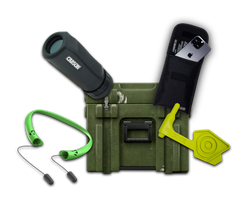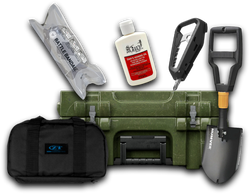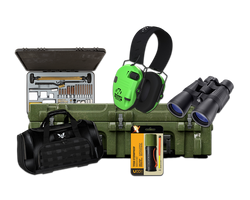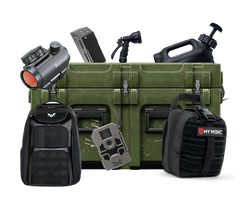Understanding How Does a Carabiner Work: The Essential Guide for Tactical Enthusiasts
Table of Contents
- Introduction
- The Basics of Carabiners: How They Work
- Types of Carabiners and Their Uses
- The Importance of Material and Durability
- Selecting the Right Carabiner for Your Needs
- Maintaining and Inspecting Your Carabiners
- Real-World Applications of Carabiners
- Conclusion
- FAQ
Introduction
Picture this: you're scaling a rock face, adrenaline coursing through your veins, and your only lifeline is a trusted carabiner securely clipped to your harness. In such high-stakes situations, understanding how does a carabiner work can mean the difference between safety and peril. Carabiners are not just simple metal clips; they are vital components of tactical and outdoor gear that require a deep understanding of their design and functionality.
Carabiners have long been a staple in various activities, from climbing and mountaineering to tactical operations and emergency rescues. Their origins trace back to the mid-20th century, when they were first designed for mountaineering, but today, they serve a multitude of purposes across various domains. As outdoor enthusiasts and tactical professionals, knowing how to choose the right carabiner and understanding its mechanics is crucial for safety and efficiency.
In this comprehensive guide, we will delve into the world of carabiners, exploring their types, features, and mechanisms. By the end of this post, you'll possess a thorough understanding of how carabiners operate, how to select the right one for your needs, and how to care for them to ensure they remain reliable in every situation.
What You Will Learn
- The basic mechanics of carabiners and how they function
- Different types of carabiners and their specific uses
- The significance of locking mechanisms and materials
- Tips for selecting the right carabiner for your specific needs
- Maintenance and inspection practices to ensure longevity and reliability
- Real-world applications and scenarios where carabiners are indispensable
With this knowledge, you'll be better prepared for any adventure, whether that's scaling a cliff or creating a secure anchor point in a tactical scenario.
The Basics of Carabiners: How They Work
At its core, a carabiner is a metal loop with a spring-loaded gate that allows for quick and secure connections. But how does a carabiner work in practice? The functionality of a carabiner can be broken down into several key components:
1. The Structure
Carabiners are typically made of durable materials such as aluminum or steel, depending on their intended use. The structure includes:
- Body: The main loop, which can be D-shaped, oval, or pear-shaped, designed to handle different loads and applications.
- Gate: The spring-loaded mechanism that allows for quick attachment and detachment.
- Spine: The straight side of the carabiner that bears the majority of the load during use.
2. How the Gate Functions
The gate is the heart of the carabiner's design. It operates through a spring mechanism, which allows it to open and close with ease. When pressure is applied to the gate, it compresses the spring, enabling the user to clip it onto a rope, harness, or other gear. Once released, the spring forces the gate back into a closed position, securing the load.
3. Load Distribution
A significant feature of carabiners is how they distribute loads. When attached to a rope or harness, the load is primarily borne by the spine. The design of most carabiners, particularly the D-shape, allows the load to be transferred efficiently from the gate to the spine, enhancing strength and reducing the risk of failure.
4. Locking Mechanisms
While standard carabiners are suitable for many applications, locking mechanisms add an extra layer of security, especially in high-risk situations. There are three primary types of locking mechanisms:
- Screw Lock: A manual locking mechanism where the user must twist the gate to secure it.
- Auto Lock: These carabiners automatically lock when the gate is closed, providing a hands-free solution.
- Triple Lock: This combines two locking methods for maximum security, often required in professional climbing and tactical operations.
Summary of Basic Mechanics
In summary, carabiners work by providing a secure, easy-to-use connection point that safely manages loads through their structural design and locking mechanisms. Understanding these basics is crucial for anyone involved in tactical activities or outdoor adventures.
Types of Carabiners and Their Uses
Carabiners come in various shapes and sizes, each designed for specific functions. Let's explore the most common types of carabiners and their applications.
1. D-Shaped Carabiners
The most widely used type, D-shaped carabiners, are known for their strength and efficient load distribution. Their shape allows them to handle significant weight, making them ideal for climbing, rescue operations, and tactical uses.
2. Oval Carabiners
Oval carabiners are symmetrical and offer versatility. They are often used in situations where a balanced load is essential, such as creating anchors or setups for pulley systems.
3. Pear-Shaped Carabiners
These carabiners are larger at the bottom, designed to accommodate additional gear such as belay devices. They are commonly used in climbing and rescue situations where multiple items need to be attached.
4. Locking Carabiners
As discussed earlier, locking carabiners provide enhanced security. They are particularly useful in situations where accidental un-clipping could lead to dangerous falls, such as in climbing or repelling.
5. Quickdraw Carabiners
Quickdraws are combinations of two carabiners connected by a sling. They are essential for rock climbers as they allow for quick attachment to bolts while minimizing rope drag.
6. Specialty Carabiners
These include various designs tailored for specific functions, such as wiregate carabiners for lightweight applications and rescue carabiners that meet high strength standards.
Summary of Carabiner Types
Understanding the different types of carabiners is essential for selecting the right one for your needs. Each type serves a specific purpose, and using the appropriate carabiner can enhance your safety and efficiency during tactical operations or outdoor adventures.
The Importance of Material and Durability
The material used in carabiner construction greatly impacts its performance and durability. Let's examine the two most common materials: aluminum and steel.
1. Aluminum Carabiners
Aluminum carabiners are lightweight and resistant to corrosion, making them an excellent choice for climbing and outdoor activities. However, they are not as strong as their steel counterparts, so they are best suited for uses where weight savings are essential, such as in sport climbing.
2. Steel Carabiners
Steel carabiners are heavier but provide superior strength and durability. They are ideal for heavy-duty applications, such as rescue operations or tactical gear. While they may not be as convenient for climbing, they offer peace of mind when handling significant loads.
Summary of Material Considerations
Choosing the right material for your carabiner is crucial for ensuring safety and performance. Aluminum is suitable for lightweight applications, while steel is best for heavy-duty situations. Always consider the specific demands of your activity when selecting a carabiner.
Selecting the Right Carabiner for Your Needs
With so many options available, it can be challenging to determine the right carabiner for your specific needs. Here are some key factors to consider:
1. Intended Use
Start by identifying the primary purpose of the carabiner. Are you using it for climbing, tactical operations, or general utility? Your intended use will dictate the type of carabiner you need.
2. Weight Capacity
Always check the weight rating (measured in kilonewtons or kN) stamped on the spine of the carabiner. Ensure the chosen carabiner can handle the maximum load you expect.
3. Locking Mechanism
Consider whether you need a locking mechanism. If you're engaging in high-risk activities, an auto-locking or triple-locking carabiner may be the safest choice.
4. Size and Shape
The size and shape of the carabiner will affect its functionality. For example, a larger pear-shaped carabiner may be necessary for belaying, while a smaller D-shaped carabiner may suffice for general use.
5. Price and Quality
Investing in high-quality carabiners is essential for ensuring your safety. While there are budget options available, prioritize quality and durability over cost.
Summary of Selection Criteria
By taking the time to evaluate these factors, you can confidently select the right carabiner for your needs, ensuring optimal performance and safety in any situation.
Maintaining and Inspecting Your Carabiners
To ensure the longevity and reliability of your carabiners, proper maintenance is essential. Here are some tips for caring for your gear:
1. Regular Inspections
Perform routine checks on your carabiners for signs of wear and tear, such as cracks, bent gates, or corrosion. If you notice any issues, retire the carabiner immediately.
2. Cleanliness
Keep your carabiners clean and free from dirt, grime, and debris. This prevents wear on the locking mechanisms and promotes smooth operation.
3. Proper Storage
Store your carabiners in a dry, cool place away from direct sunlight. Avoid leaving them in damp or humid environments that could lead to corrosion.
4. Avoid Cross-Loading
Cross-loading occurs when a carabiner is loaded on the spine instead of the gate. This can significantly reduce its strength. Always attach your carabiner correctly to avoid this hazard.
5. Retirement Guidelines
Many manufacturers provide guidelines for when to retire carabiners based on usage. As a rule of thumb, if a carabiner has been involved in a fall, has visible damage, or has been used extensively, consider replacing it.
Summary of Maintenance Practices
By adhering to these maintenance and inspection practices, you can ensure your carabiners remain safe and reliable throughout their lifespan.
Real-World Applications of Carabiners
Carabiners play a vital role in various real-world applications, demonstrating their versatility beyond recreational climbing.
1. Tactical Operations
In the military and law enforcement, carabiners are essential for securing gear, creating anchor points, and rappelling. Their strength and reliability are crucial in high-stakes situations.
2. Rescue Operations
Search and rescue teams frequently use carabiners to create secure systems for lifting and lowering victims. The ability to quickly attach and detach gear can save lives in emergency situations.
3. Industrial Uses
In industrial settings, carabiners are used for rigging, securing equipment, and creating safe work environments. They are instrumental in ensuring worker safety in hazardous environments.
4. Outdoor Adventures
From camping to hiking, carabiners serve countless purposes for outdoor enthusiasts. They can secure gear to backpacks, create anchor points for tarps, or attach equipment to climbing harnesses.
Summary of Applications
Understanding the various applications of carabiners highlights their importance not only in recreational activities but also in professional and industrial settings. Their versatility makes them an invaluable tool in diverse environments.
Conclusion
In conclusion, understanding how does a carabiner work is fundamental for anyone involved in tactical activities, climbing, or outdoor adventures. By grasping the mechanics, types, materials, and maintenance practices, you can confidently select and utilize carabiners to enhance your safety and efficiency.
Whether you're a seasoned climber, a tactical professional, or simply an outdoor enthusiast, having the right knowledge about carabiners empowers you to make informed decisions in critical situations. Remember to regularly inspect your gear, select carabiners that fit your specific needs, and always prioritize safety.
As you continue your journey, consider exploring Crate Club's subscription services for curated tactical gear, including high-quality carabiners. With options tailored to every level of enthusiast, Crate Club is committed to ensuring you have the best tools for your adventures.
Explore our subscriptions here: Crate Club Subscription Services and check out our shop for top-notch gear: Crate Club Shop.
FAQ
What weight can a typical carabiner hold?
The weight capacity of carabiners varies by type and material. Standard climbing carabiners typically have a strength rating between 20 kN to 30 kN, which translates to approximately 4,500 to 6,700 pounds. Always check the manufacturer's specifications for specific ratings.
How often should I replace my carabiners?
It's recommended to inspect carabiners regularly. If a carabiner shows signs of wear, has been involved in a fall, or has been used extensively, it's best to retire it. Some manufacturers suggest replacing carabiners every few years, even if they show no visible damage.
Can I use a regular carabiner for climbing?
While you can use a regular carabiner, it is essential to choose one specifically rated for climbing. Ensure it meets industry standards and has the appropriate strength rating for your intended use.
What is the difference between locking and non-locking carabiners?
Locking carabiners have mechanisms that secure the gate, preventing accidental openings. Non-locking carabiners do not have this feature and are typically used in situations where quick access is more critical than security.
Are all carabiners made from the same materials?
No, carabiners can be made from various materials, with aluminum and steel being the most common. Aluminum is lightweight and corrosion-resistant, while steel is heavier but offers superior strength and durability.
By understanding these common questions, you can enhance your knowledge of carabiners and make informed decisions for your adventures and tactical operations.
Share this article



